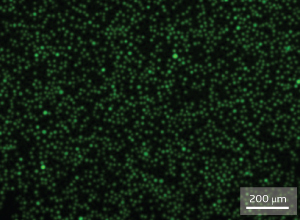A safe way to manipulate immune cells

Fluorescence microscopy image showing green fluorescent protein expression in sonoporated human B cells. © 2014 WILEY-VCH Verlag GmbH & Co. KGaA, Weinheim
The introduction of foreign DNA into human cells through a process known as ‘transfection’ allows scientists to study gene expression in the laboratory and enables clinicians to treat genetic diseases. The methods commonly used for this procedure work for most cell types, except when it comes to B cells — a group of infection-fighting white blood cells in the immune system that have proven extremely difficult to transfect without the use of viruses. Viruses, however, pose a number of safety issues.
A team led by scientists at the A*STAR Bioprocessing Technology Institute and the A*STAR Institute of High Performance Computing has now developed a non-viral strategy to deliver DNA into this intractable cell type. By optimizing a technique termed sonoporation, the researchers managed to introduce genes into B cells with high rates of success1.
“Our work is the first to demonstrate the use of sonoporation as an alternative, non-viral method for stable and highly efficient transfection of recalcitrant B cell lines,” says biomedical engineer and study leader Andre Boon-Hwa Choo.
Sonoporation combines ultrasonic sound frequencies and tiny gas-filled bubbles to generate transient pores in the cell membrane through which DNA can travel. Choo and his colleagues tweaked the acoustic energy levels and microbubble concentrations to deliver a circular piece of DNA that they could track visually in a trio of human B cell lines.
In one cell line, for example, the researchers achieved around 43 per cent transfection efficiency through sonoporation, compared to just 3 per cent with a conventional transfection method called lipofection (see image). Through further selection techniques, the researchers enriched the population of transfected B cells to more than 70 per cent. They achieved similarly impressive results with the two other B cell lines.
According to Charlene Li Ling Yong, co-first-author of the study along with Dave Siak-Wei Ow, the sonoporation-based transfection technique can now be used in the laboratory to better understand how B cells regulate immune responses against pathogens. “It allows scientists to elucidate the biological pathways of immune responses,” says Yong.
Numerous clinical research teams are also pursuing B-cell-based gene therapies to induce tolerance against autoimmune diseases. The method described in the current study could come in particularly handy for treatments in the human body — without any of the adverse effects of viral-mediated gene therapy. “Sonoporation has the potential to be applied in vivo,” Ow says. “It offers a safer and noninvasive alternative to existing gene therapies.”
The A*STAR-affiliated researchers contributing to this research are from the Bioprocessing Technology Institute and the Institute of High Performance Computing
- Yong, C. L. L., Ow, D. S.-W., Tandiono, T., Heng, L. L. M., Chan, K. K.-K., Ohl, C.-D., Klaseboer, E., Ohl, S.-W. & Choo, A. B.-H. Microbubble-mediated sonoporation for highly efficient transfection of recalcitrant human B- cell lines. Biotechnology Journal 9, 1081–1087 (2014). | article
Media Contact
All latest news from the category: Life Sciences and Chemistry
Articles and reports from the Life Sciences and chemistry area deal with applied and basic research into modern biology, chemistry and human medicine.
Valuable information can be found on a range of life sciences fields including bacteriology, biochemistry, bionics, bioinformatics, biophysics, biotechnology, genetics, geobotany, human biology, marine biology, microbiology, molecular biology, cellular biology, zoology, bioinorganic chemistry, microchemistry and environmental chemistry.
Newest articles

Combatting disruptive ‘noise’ in quantum communication
In a significant milestone for quantum communication technology, an experiment has demonstrated how networks can be leveraged to combat disruptive ‘noise’ in quantum communications. The international effort led by researchers…

Stretchable quantum dot display
Intrinsically stretchable quantum dot-based light-emitting diodes achieved record-breaking performance. A team of South Korean scientists led by Professor KIM Dae-Hyeong of the Center for Nanoparticle Research within the Institute for…

Internet can achieve quantum speed with light saved as sound
Researchers at the University of Copenhagen’s Niels Bohr Institute have developed a new way to create quantum memory: A small drum can store data sent with light in its sonic…





















